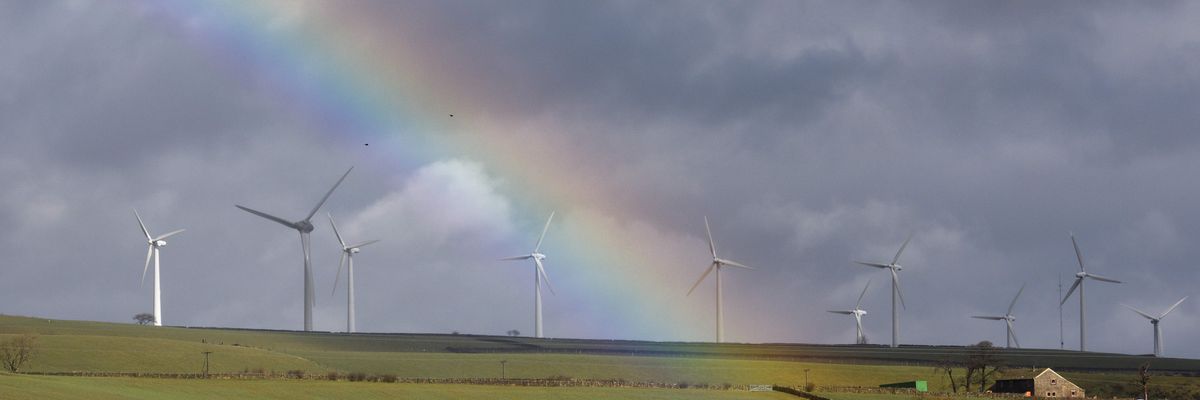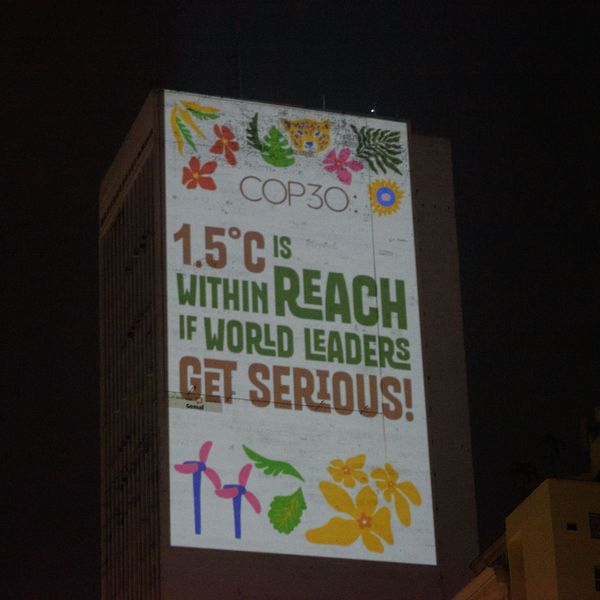
A rainbow illuminates the sky above a windfarm in Wortley, near Sheffield, northern England, on March 1, 2016.
A Full-Court Press for Renewables Will Save Money and the Planet
Although there are up front costs of building solar and wind farms, these new energy plants will pay for themselves over time, and by the 2040s energy will be much cheaper.
Last week, the International Energy Agency put out a new report that turns conventional wisdom regarding the clean energy transition on its head.
It is cheaper for everyone to adopt solar, wind, batteries, and other renewables as soon as possible than to go on depending on coal, fossil gas, and petroleum. And we’re just talking about energy costs in a vacuum here, not factoring in the climate change damage that fossil fuels do to the planet, which costs billions of dollars a year and will cost ever more as time goes on.
The report’s authors write that in China in 2023, “more than 95% of new utility-scale solar photovoltaic (PV) installations and new onshore wind capacity had lower generation costs than new coal and natural gas plants. Where electric cars and two- and three-wheelers have higher upfront costs, which is not always the case, they typically result in substantial savings because of lower operating expenses.”
Since the cost of producing electricity by solar is falling so fast, whereas petroleum prices are either stable or slated to rise, if we shift from oil to electricity we obviously are saving a lot of money.
I repeat, solar and wind had lower generation costs. And no wonder, since the cost of solar panels plummeted an astonishing 30% in 2023. And we’re only at the beginning of the transition. Between 2009 and 2019, the price of solar electricity dropped 89%. Think about the last 10 years of gasoline prices in the U.S. The average price of gasoline in 2014 was about $3 per gallon. In 2023 it was $3.52. In real terms, accounting for inflation, the price was probably about flat or down just a wee bit. Fossil fuels are remaining just as expensive as they always were, but renewables are rapidly declining in price. These declines will continue as new technologies are invented and implemented.
Although there are up front costs of building solar and wind farms, these new energy plants will pay for themselves over time, and by the 2040s energy will be much cheaper. The IEA says, “Today, around 50% of total consumer energy expenditure is on oil products, and another 35% is on electricity. In rapid energy transitions these swap places, making the price of electricity the key measure of affordability for most consumers.”
Since the cost of producing electricity by solar is falling so fast, whereas petroleum prices are either stable or slated to rise, if we shift from oil to electricity we obviously are saving a lot of money.
But, we’re going to need some major investments up front to unlock these lower prices. The report says: “As things stand, around $3 trillion is invested each year into the energy sector, of which $1.9 trillion is in a range of clean energy technologies and infrastructure. By 2035, total investments need to rise to $5.3 trillion in the NZE Scenario, with $5 trillion going to clean energy.”
The bottom line is the bill you get from your energy utility every month, and your monthly cost for transpiration fuel. The IEA observes, “Our projections highlight that rapid clean energy transitions result in lower consumer bills compared with a trajectory based on today’s policy settings.”
If we stop subsidizing fossil fuels and put the money instead into a Manhattan Project-style full-court press for renewables, in 11 years consumers could be paying 20% less for their energy, especially in the developing world.
An Urgent Message From Our Co-Founder
Dear Common Dreams reader, The U.S. is on a fast track to authoritarianism like nothing I've ever seen. Meanwhile, corporate news outlets are utterly capitulating to Trump, twisting their coverage to avoid drawing his ire while lining up to stuff cash in his pockets. That's why I believe that Common Dreams is doing the best and most consequential reporting that we've ever done. Our small but mighty team is a progressive reporting powerhouse, covering the news every day that the corporate media never will. Our mission has always been simple: To inform. To inspire. And to ignite change for the common good. Now here's the key piece that I want all our readers to understand: None of this would be possible without your financial support. That's not just some fundraising cliche. It's the absolute and literal truth. We don't accept corporate advertising and never will. We don't have a paywall because we don't think people should be blocked from critical news based on their ability to pay. Everything we do is funded by the donations of readers like you. Will you donate now to help power the nonprofit, independent reporting of Common Dreams? Thank you for being a vital member of our community. Together, we can keep independent journalism alive when it’s needed most. - Craig Brown, Co-founder |
Last week, the International Energy Agency put out a new report that turns conventional wisdom regarding the clean energy transition on its head.
It is cheaper for everyone to adopt solar, wind, batteries, and other renewables as soon as possible than to go on depending on coal, fossil gas, and petroleum. And we’re just talking about energy costs in a vacuum here, not factoring in the climate change damage that fossil fuels do to the planet, which costs billions of dollars a year and will cost ever more as time goes on.
The report’s authors write that in China in 2023, “more than 95% of new utility-scale solar photovoltaic (PV) installations and new onshore wind capacity had lower generation costs than new coal and natural gas plants. Where electric cars and two- and three-wheelers have higher upfront costs, which is not always the case, they typically result in substantial savings because of lower operating expenses.”
Since the cost of producing electricity by solar is falling so fast, whereas petroleum prices are either stable or slated to rise, if we shift from oil to electricity we obviously are saving a lot of money.
I repeat, solar and wind had lower generation costs. And no wonder, since the cost of solar panels plummeted an astonishing 30% in 2023. And we’re only at the beginning of the transition. Between 2009 and 2019, the price of solar electricity dropped 89%. Think about the last 10 years of gasoline prices in the U.S. The average price of gasoline in 2014 was about $3 per gallon. In 2023 it was $3.52. In real terms, accounting for inflation, the price was probably about flat or down just a wee bit. Fossil fuels are remaining just as expensive as they always were, but renewables are rapidly declining in price. These declines will continue as new technologies are invented and implemented.
Although there are up front costs of building solar and wind farms, these new energy plants will pay for themselves over time, and by the 2040s energy will be much cheaper. The IEA says, “Today, around 50% of total consumer energy expenditure is on oil products, and another 35% is on electricity. In rapid energy transitions these swap places, making the price of electricity the key measure of affordability for most consumers.”
Since the cost of producing electricity by solar is falling so fast, whereas petroleum prices are either stable or slated to rise, if we shift from oil to electricity we obviously are saving a lot of money.
But, we’re going to need some major investments up front to unlock these lower prices. The report says: “As things stand, around $3 trillion is invested each year into the energy sector, of which $1.9 trillion is in a range of clean energy technologies and infrastructure. By 2035, total investments need to rise to $5.3 trillion in the NZE Scenario, with $5 trillion going to clean energy.”
The bottom line is the bill you get from your energy utility every month, and your monthly cost for transpiration fuel. The IEA observes, “Our projections highlight that rapid clean energy transitions result in lower consumer bills compared with a trajectory based on today’s policy settings.”
If we stop subsidizing fossil fuels and put the money instead into a Manhattan Project-style full-court press for renewables, in 11 years consumers could be paying 20% less for their energy, especially in the developing world.
- With 10-Point Declaration, Global Coalition of Top Energy Experts Says: '100% Renewables Is Possible' ›
- 'Big Win': New York to Build Publicly Owned Clean Energy, Electrify New Buildings ›
- EPA, Sanders Launch $7 Billion Program to Expand Rooftop Solar in Poor Neighborhoods ›
- Analysts Say Solar Is Saving Texans From Widespread Power Outages Amid Extreme Heat ›
- The US Can Go Fossil Free -- Here's How ›
Last week, the International Energy Agency put out a new report that turns conventional wisdom regarding the clean energy transition on its head.
It is cheaper for everyone to adopt solar, wind, batteries, and other renewables as soon as possible than to go on depending on coal, fossil gas, and petroleum. And we’re just talking about energy costs in a vacuum here, not factoring in the climate change damage that fossil fuels do to the planet, which costs billions of dollars a year and will cost ever more as time goes on.
The report’s authors write that in China in 2023, “more than 95% of new utility-scale solar photovoltaic (PV) installations and new onshore wind capacity had lower generation costs than new coal and natural gas plants. Where electric cars and two- and three-wheelers have higher upfront costs, which is not always the case, they typically result in substantial savings because of lower operating expenses.”
Since the cost of producing electricity by solar is falling so fast, whereas petroleum prices are either stable or slated to rise, if we shift from oil to electricity we obviously are saving a lot of money.
I repeat, solar and wind had lower generation costs. And no wonder, since the cost of solar panels plummeted an astonishing 30% in 2023. And we’re only at the beginning of the transition. Between 2009 and 2019, the price of solar electricity dropped 89%. Think about the last 10 years of gasoline prices in the U.S. The average price of gasoline in 2014 was about $3 per gallon. In 2023 it was $3.52. In real terms, accounting for inflation, the price was probably about flat or down just a wee bit. Fossil fuels are remaining just as expensive as they always were, but renewables are rapidly declining in price. These declines will continue as new technologies are invented and implemented.
Although there are up front costs of building solar and wind farms, these new energy plants will pay for themselves over time, and by the 2040s energy will be much cheaper. The IEA says, “Today, around 50% of total consumer energy expenditure is on oil products, and another 35% is on electricity. In rapid energy transitions these swap places, making the price of electricity the key measure of affordability for most consumers.”
Since the cost of producing electricity by solar is falling so fast, whereas petroleum prices are either stable or slated to rise, if we shift from oil to electricity we obviously are saving a lot of money.
But, we’re going to need some major investments up front to unlock these lower prices. The report says: “As things stand, around $3 trillion is invested each year into the energy sector, of which $1.9 trillion is in a range of clean energy technologies and infrastructure. By 2035, total investments need to rise to $5.3 trillion in the NZE Scenario, with $5 trillion going to clean energy.”
The bottom line is the bill you get from your energy utility every month, and your monthly cost for transpiration fuel. The IEA observes, “Our projections highlight that rapid clean energy transitions result in lower consumer bills compared with a trajectory based on today’s policy settings.”
If we stop subsidizing fossil fuels and put the money instead into a Manhattan Project-style full-court press for renewables, in 11 years consumers could be paying 20% less for their energy, especially in the developing world.
- With 10-Point Declaration, Global Coalition of Top Energy Experts Says: '100% Renewables Is Possible' ›
- 'Big Win': New York to Build Publicly Owned Clean Energy, Electrify New Buildings ›
- EPA, Sanders Launch $7 Billion Program to Expand Rooftop Solar in Poor Neighborhoods ›
- Analysts Say Solar Is Saving Texans From Widespread Power Outages Amid Extreme Heat ›
- The US Can Go Fossil Free -- Here's How ›

